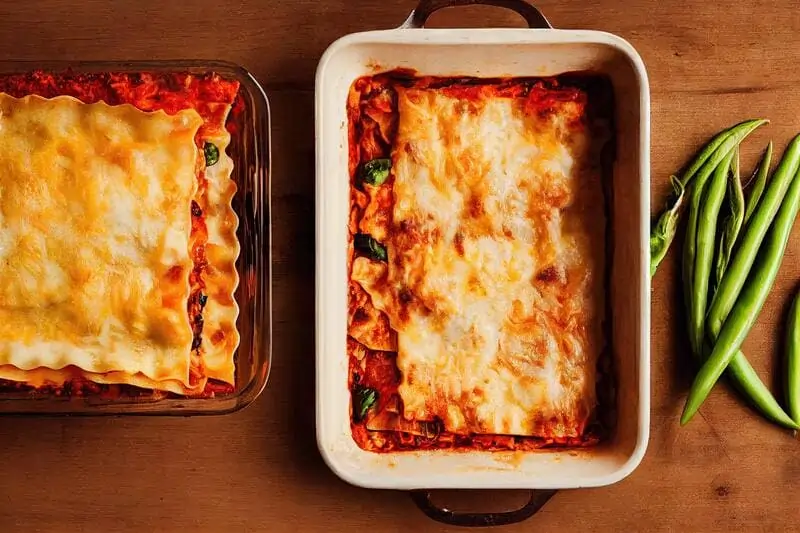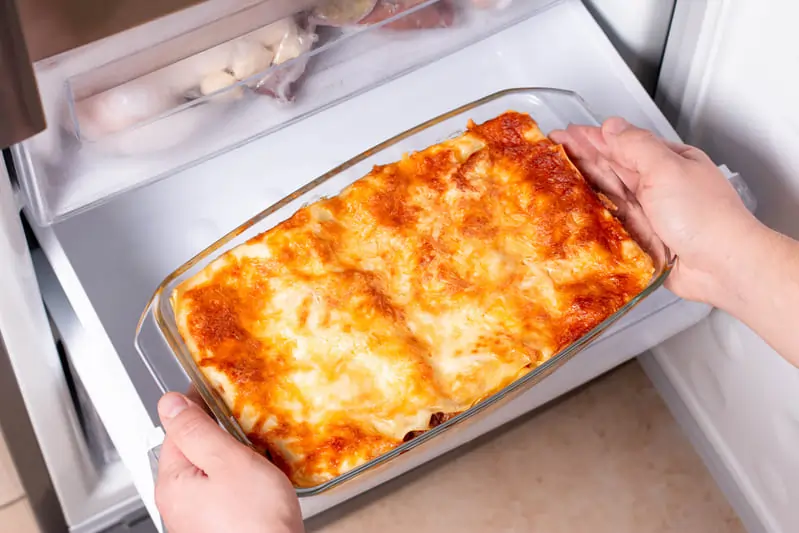Why the Debate?
Experts like those at Tasting Table recommend covering lasagna initially to trap steam and ensure even cooking. Meanwhile, avoiding mistakes like overcooking or uneven layering, as highlighted by La Cucina Italiana, can enhance your lasagna results significantly.
For a comprehensive guide to perfect lasagna preparation, you may also want to check this classic Barilla lasagna recipe.
Baking Lasagna Covered

Benefits of Covering Lasagna
- Traps Moisture: Covering lasagna with aluminum foil keeps the dish moist. It prevents noodles from drying out and ensures all layers stay hydrated for perfect cooking.
- Even Cooking: A cover creates steam, circulating heat evenly. This helps cook the sauce, pasta, and cheese uniformly, avoiding raw or overly dry spots.
- Reduces Risk of Burning: Covering protects the top layer from browning or burning too quickly. It ensures the surface stays tender while the interior cooks through.
When to Cover Your Lasagna
The decision to cover lasagna should be tailored to the specific needs of the dish you are preparing. It is especially beneficial:
- For Recipes with Pre-cooked Noodles: If your lasagna uses noodles that have been pre-cooked or are more delicate, covering during the initial baking phase helps to preserve their texture and integrity.
- For High Moisture Lasagnas: Dishes with a lot of liquid, such as those with abundant sauce or vegetables that release moisture, benefit from being covered so that the liquid does not evaporate too quickly, which helps to keep the lasagna succulent.
- When Baking at High Temperatures: If you are baking the lasagna at a higher temperature to shorten the cooking time, covering it can prevent the top from getting too dark while the rest of the dish catches up.
Additionally, for those looking for creative ways to layer their dishes, exploring simple baking tips for layered desserts might provide new techniques that can be applied to lasagna. These methods can offer inspiration for arranging ingredients in a way that maximizes flavors and textures, making your lasagna a standout dish.
Baking Lasagna Uncovered
Benefits of Baking Uncovered
Golden Brown Topping: Baking your lasagna uncovered allows the cheese on top to receive direct heat, which helps it crisp up and turn a beautiful golden brown. This not only enhances the texture but also adds a rich flavor to the dish.
Thicker Sauce: As the lasagna bakes, moisture evaporates from the sauce, which concentrates its flavors and thickens its consistency. This process enhances the overall taste of the lasagna, ensuring that each bite is packed with a robust and savory sauce.
Rustic Appearance: An uncovered lasagna typically develops a more rustic, appealing crust that suggests a homemade and heartily prepared meal. This aesthetic is often sought after for its artisanal quality and visually inviting presentation.
When to Bake Lasagna Uncovered
Choosing the right time to bake lasagna uncovered can significantly affect the outcome:
- For Optimal Browning: Remove the cover during the final 15–20 minutes of baking. This allows the top layer to achieve that desirable golden crispness without overcooking the rest of the dish.
- With Thick, Sturdy Pasta Layers: If your lasagna features thicker or more robust pasta, baking it uncovered can help manage moisture levels, ensuring that the pasta cooks perfectly without becoming soggy.
- For a Crispy Finish: To emulate a restaurant-style crust on the top layer of your lasagna, baking uncovered is essential. This method gives the top a crispy texture that contrasts wonderfully with the softer layers beneath.
Moreover, for those aiming to balance moisture and achieve an evenly cooked lasagna, consulting a guide on moist baking techniques can be extremely useful. Such resources can offer insights into managing heat and moisture in the oven, ensuring that dishes like lasagna come out perfectly every time. These tips are invaluable for both novice cooks and seasoned chefs alike, helping to refine their baking processes and enhance the quality of their meals.
Common Mistakes to Avoid

Expert Recommendations for Baking Lasagna
1. The Hybrid Baking Method
Culinary professionals agree that the best way to bake lasagna is to start with a hybrid baking method. First, cover the lasagna with foil for approximately two-thirds of the total cooking time. Covering the dish helps trap moisture, ensuring the noodles cook thoroughly and the layers meld harmoniously. Additionally, this approach prevents the lasagna from drying out and promotes even heat distribution throughout the dish.
2. Removing the Foil for a Crispy Finish
After the initial covered cooking phase, it is recommended to remove the foil for the final 15–20 minutes of baking. This step allows the top layer of cheese and sauce to receive direct heat, leading to a beautifully golden and crispy finish. As a result, the lasagna achieves a more vibrant and textured surface. Moreover, the contrast between the crispy top and the tender layers beneath adds a delightful bite to the dish.
3. Implementing the Technique
For instance, the Best Homemade Lasagna Recipe incorporates this two-phase baking strategy. Starting with the lasagna covered snugly with foil ensures essential moisture remains trapped, which is crucial for cooking the pasta and melding the flavors. Then, as the cooking nears completion, removing the foil allows the top to brown nicely, creating the coveted golden crust loved by diners.
4. Benefits of the Hybrid Method
This hybrid baking method balances moisture retention with the desire for a textured, appetizing top layer. By following this approach, you can elevate a simple lasagna to restaurant-quality levels, impressing guests and satisfying all kinds of palates.
5. Additional Resources for Mastery
If you’re interested in exploring this method further, consult detailed guides and recipes found in comprehensive cookbooks or culinary websites. These resources provide additional insights and variations on perfecting your lasagna using expert-recommended techniques. Ultimately, they are invaluable tools for enhancing your cooking skills and expanding your repertoire of dishes.
Common Mistakes to Avoid
Common Mistakes to Avoid in Lasagna Preparation
Baking Completely Uncovered: While it might be tempting to bake lasagna uncovered to achieve a crispy top, doing so for the entire cooking duration can lead to less desirable results. This approach often causes the noodles to dry out and the edges to overcook or even burn. To prevent this, it’s essential to cover the lasagna for a portion of the baking time, thereby preserving the moisture within the layers.
Over-Covering the Dish: On the flip side, keeping the lasagna covered throughout the entire baking process can also create issues. Excessive coverage traps too much steam and moisture, which can turn your lasagna into a soupy mess. To strike the right balance, remove the covering towards the end of baking to allow some of the steam to escape and the top layer to develop a more appealing texture and color.
Neglecting Layering Techniques: Proper layering is crucial in lasagna preparation. Failing to evenly distribute sauce, cheese, and fillings can lead to uneven cooking, where some pasta layers may end up undercooked and stiff, while others might absorb too much moisture, leading to overcooked, mushy fillings. It’s important to spread each component uniformly, ensuring that every bite is as perfect as the next.
Tips for Perfect Layering
To improve your lasagna’s structure and cooking outcome, follow these tips:
- Even Sauce Distribution: Ensure that every layer of noodles is covered with a sufficient amount of sauce. This not only prevents the noodles from drying out but also helps in cooking them evenly.
- Balanced Filling Layers: Apply fillings such as cheese, meat, or vegetables in consistent layers. This uniformity prevents the lasagna from becoming too bulky in some sections and too thin in others.
- Top Layer Attention: Finish with a generous layer of cheese and sauce on the top. This not only adds flavor but also protects the uppermost noodles from drying out during the uncovered phase of baking.
By avoiding these common mistakes and applying these layering techniques, you can ensure that your lasagna is deliciously moist and perfectly cooked throughout. For further guidance, consider checking detailed culinary guides or lasagna-specific recipes on reputable cooking sites, where experienced chefs share their tips and tricks for mastering this beloved dish. These resources can be instrumental in helping you refine your technique and achieve lasagna perfection.
Frequently Asked Questions
1. Should I cover lasagna for the entire bake time?
No, it’s best to cover lasagna for the first two-thirds of baking and uncover it for the final 15–20 minutes. This ensures the dish stays moist while developing a crispy, golden topping. For a detailed guide on achieving the perfect balance, check out this comprehensive lasagna baking recipe.
2. Can I use parchment paper instead of foil?
Yes, but parchment paper may not retain moisture as effectively as foil. For best results, use aluminum foil during the initial bake. Learn more about layering techniques and baking essentials in this step-by-step guide to making layered dishes.
3. What happens if I bake lasagna uncovered from the start?
Baking uncovered for the entire time can dry out the noodles and leave the edges overcooked. To avoid this, explore these tips for maintaining moisture and texture in baked dishes.
4. Can I freeze lasagna before baking? Should I cover it?
Yes, you can freeze lasagna before baking. It’s recommended to cover it tightly with foil to prevent freezer burn and retain moisture during reheating. For more tips on preparing dishes ahead of time, refer to this guide on freezing and baking techniques.
Final Thoughts: The Best Approach
The choice between covered and uncovered lasagna depends on your recipe, preferences, and desired outcome. For most, a balanced approach works best—bake the lasagna covered initially to retain moisture and uncover it towards the end to achieve that irresistible golden-brown topping.
By understanding these methods and experimenting with your favorite recipes, you’ll soon master the art of baking the perfect lasagna every time. Whether you’re making a simple family dinner or hosting a gathering, following these tips will elevate your dish to the next level.
For additional baking techniques, explore this step-by-step guide to crafting layered dishes.

